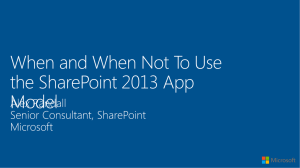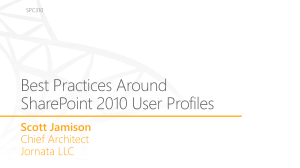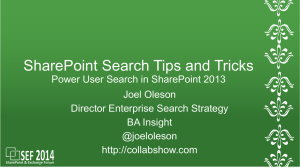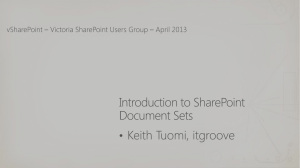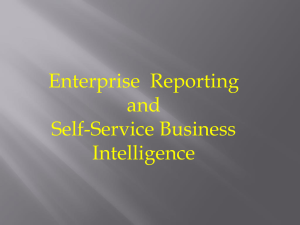movinonuphspug-140220102908-phpapp01
advertisement
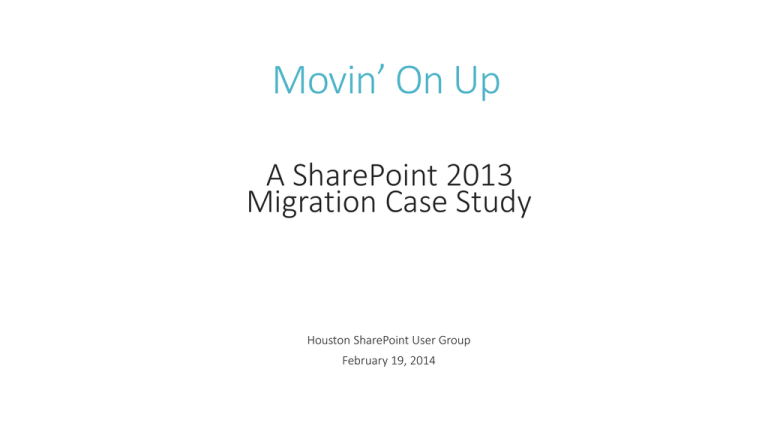
Movin’ On Up A SharePoint 2013 Migration Case Study Houston SharePoint User Group February 19, 2014 Jim Adcock, The SharePoint Therapist Director, Enterprise Development Dynamic Systems http://dlairman.wordpress.com http://SharePointTherapist.com @dlairman Focused on Governance, User Adoption, Business Process Automation Thursdays at 11:30 am Fridays at 10:00 am The Clients A nearly century-old construction company (slow to make changes) A 40 year old construction company (with many of its employees dating back to the company’s founding) The Environment Existing SharePoint 2007 ~400 GB in the content DB Pilot SharePoint 2010 Records Center Office 365 Project that needed ability to collaborate with external entities, not enough resources at the time to set up their own extranet External services (some approved, some not) Box, Dropbox, etc. The Goal SharePoint 2013 On-premises Unified environment Business Drivers Some performance issues in 2007 (All 400 GB in a single content DB) Unhelpful search results Required support for legacy customizations Low user adoption Lots of files sent via e-mail Shadow resources may be in use (Box, etc.) Access controls out of control Lots of folders! (Intentionally designed to mirror the old paper document storage) Proposed Solution Migrate content into new environment using third-party tool Cleans up access controls Allows creation and assignment of content types Leaves behind stale content No customization ghosts Realign content into smaller content databases Alternative – script migration using PowerShell Challenges Resources dedicated to SAP implementation Funding limitations Server resources Turnover of SharePoint staff Datacenter and office move Users not happy with current SharePoint environment (Therefore SharePoint sucks!) Anyone know what this is? User’s view of SharePoint Potential Wins Once the migration is complete: Resources dedicated to supporting the two older environments can be reclaimed Costs of the cloud environment and approved third-party cloud services eliminated SP2013 costs less than SP2010, skipping 2010 makes sense Example Savings # of Internal Users 100 # of Servers 2 Internal CAL Enterprise (Est.) Cost SharePoint 2010 $ 82 $ 40,000 $ 88,200 SharePoint 2013 $ 94 $ 7,000 $ 23,400 $ 64,800 Saving (Est.): Choices: Legacy SharePoint Customizations Retired Replaced w/ other (non-SharePoint) solutions Replaced using OOTB SP2013 features Must be rebuilt with the App model Use SharePoint The Plan Documents customized to reflect the existing environment and desired outcomes labeled as “Plan”, and as-yet un-customized docs are “Templates”. As the templates get filled out, they become plans. To Do Engage the users! Determine Governance Determine Architecture Install Servers and Software Configure 2013 Environment User Training Content Migration Application Migration Decommission 2007 and 2010 User Engagement Contest: Name SharePoint! $50 prize! Nearly 1/3 of users participated! 52 Suggestions 94 Votes in 1st round, 125 in 2nd 25 15 5 5 Survey: What do you like/hate about the current system? 4 4 #sharepointallthethings Because that’s a good idea, right? Governance Identify Key Stakeholders Project Kickoff Meeting Vision and Goals Decisions List These decisions feed into Architecture design Governance & Architecture Recommended Architecture Upgrade project kickoff meeting with key stakeholders (Presentation Rough Draft) MAKE IT BETTER! INTRANET MIGRATION TO SHAREPOINT 2013 WE’RE GETTING AN UPGRADE • SharePoint 2013 has some great new features – including a more intuitive interface! • Streamlined Permissions – it will be easier for you to get access to your stuff! • Better Search – it will be easier for you to find what you are looking for! BETTER SEARCH! • So significant, I had to mention it again! • You know how Google has gotten better over the years at giving you what you are looking for? Microsoft has figured out that it needs to step up its game. MOST IMPORTANT… We are trying to make work easier for you. THAT’S THE CARROT • Carrots are good for you! • But you aren’t a horse, and carrots may not be your favorite food… • In other words, while it is good for you, you might have to “eat” some things that you may not like the taste of in order to reap the benefits. CHANGE CAN BE HARD…. • But we are going to do everything we can to make it as easy as possible to get to the good stuff. WHY SHAREPOINT? Provides a secure place to store documents • • • • • Always backed up Always available (cloud!) Version control Access control Alerts – stay informed of changes! WHY SHAREPOINT? Workflow automates business processes Spend less time managing processes and more time accomplishing things! WHY SHAREPOINT? Empower users – get IT out of the way of business! WHY SHAREPOINT? PC Backup Availability Version Control Access Control Workflow Alerts Network Share SharePoint A FEW CHANGES… • Additional Governance - Consistent look and feel across the organization • Better experience for the end users – you! • More consistent system behavior • More consistent search results! • Behavior - Never add another attachment to e-mail • Cost savings! • No more playing “Which version is correct?” • No more folders! • Say what?!?!? FILE FOLDERS ARE SO 19TH CENTURY • Prior to 1898, businesses kept papers in envelopes in turn stored in arrays of pigeonholes often lining a wall. Finding and opening envelopes and unfolding papers was troublesome and inefficient. • The vertical filing cabinet (more or less as in use today) was invented by Edwin G. Seibels in 1898. Seibels reasoned that folding was not necessary; papers could be kept in large envelopes standing on end vertically in a drawer. • Electronic folders are designed to mimic the separation provided by the 1898 invention. LIMITING YOUR VIEW • Folders limit your view of information to only the way the data is separated by the folders • But what if you wanted to look at the data a different way? HOW WE FIND STUFF • Then: Location was everything • Now: Search is king. Search is so much the prevalent way we find things that we don’t even call it “searching” anymore. We call it after a common search appliance – we “Google” things now! (Even when we are using Bing! Sorry, MS!) • Search gives you what you are looking for when you are looking for it CONTAINERS ARE FOR LOCKING • Use containers (like sites, libraries or folders) to create security zones. • Use labels – tags and “metadata” to group things by what they are and make them findable • Use “content types” to determine what types of labels can be applied, and how to handle the document lifecycle TRAINING! • A big change like this is an opportunity to address training gaps • A big part of helping you to get the most out of SharePoint is teaching you how to get the most out of SharePoint MAKE USERS HAPPIER • Easier to use • More effective, giving you time to spend on things that matter! MAKE MANAGEMENT HAPPIER • • • • Cost reductions! Increased efficiency! (More cost reductions!) More focus on capturing business (more profit!) More focus on improving services (happier customers, more profit!) PROPOSED VISION STATEMENT “The Portal provides an environment where, in one organized, intuitive and searchable location employees will find the systems, tools, information and collaboration areas that they need. From any internet-connected computer, employees will be able to realize greater efficiency accessing important business systems, people information, company forms, news, benefits summaries, calendars and other company information. The portal will provide tools for teams to collaborate and share documents, timelines, status reports and other communication, thus providing additional benefit to our customers, and our industry partners in a secure and efficient way.” Stakeholders provide input at this step Out of Scope In Scope Utilized by Business Users to develop and implement business solutions that use technology without IT’s direct involvement. Utilized by IT to develop and implement more advanced technical solutions through a unified application delivery platform. The primary repository for document sharing, collaboration, and communication. The primary location for simple workflow/business process automation. The employee Portal and communication center for internal corporate communications. The primary project issue tracking system with the support of Project Server. x The repository for any XYZ documents and processes. The platform used for customer relationship management. (Recommend OOS) The learning management system used by our organization. (Recommend OOS) Utilized as an asset management system. The ticket tracking system for our operational issues. The work order management system used by our organization. Stakeholders provide input at this step Install the Servers Virtualized environment, can clone base OS Dev, Test and Production environments How do you create multiple environments with consistency? PowerShell! User Training Often the most overlooked requirement for successful rollout! Training begins as soon as the Dev environment is stood up. Open for Business Open the 2013 site for use Search crawls 2007 content New home pages for each department Links to 2007 site content until migrated Content Migration Test migration of content to Test environment Move IT first – dog food! Validate the migration test in Test Use the validated migration to re-migrate to Prod. Final validation in Production Customization Migration Recreate customizations from 2007 that the business needs to carry forward into 2013 Can be done in parallel to Content Migration Decommission 2007 and 2010 Final backup Turn off VMs Wait to see if anyone screams “My data!” Release resources All done! Resources Architecture Designs http://technet.microsoft.com/en-us/sharepoint/fp123594.aspx Planning Resources http://technet.microsoft.com/en-us/library/cc261834.aspx http://jimehrenberg.wordpress.com/2013/07/22/an-oldie-but-a-goodie-sharepoint-2013-version-comparison-chart/ http://sharepointpromag.com/blog/migrating-sharepoint-2007-sharepoint-2013-part-1 http://sharepointpromag.com/blog/migrating-sharepoint-2007-sharepoint-2013-part-2 Governance Resources http://www.rharbridge.com/?page_id=726 http://kjellsj.blogspot.com/2010/05/sharepoint-governance-part-i-eating.html http://technet.microsoft.com/en-us/library/ff848257(v=office.14).aspx http://sharepointtherapist.com/ Install Scripts http://gallery.technet.microsoft.com/DownloadInstall-SharePoint-e6df9eb8 http://autospinstaller.codeplex.com/ http://blog.tedpattison.net/Lists/Posts/Post.aspx?List=9d54806e%2D14ca%2D456d%2Da62a%2Db903c9dda841&ID=24&Web=dbc8a5bc%2Dc0d9%2D412c%2D8929%2D17 7a045a5351 Some Training Resources http://www.discoversharepoint.com/ http://office.microsoft.com/en-us/sharepoint-help/training-courses-for-sharepoint-2013-HA104030990.aspx http://www.brainstorminc.com/for-business/train-by-type/quick-start-cards/microsoft/sharepoint/productid/208 http://www.youtube.com/playlist?list=PLCB216CC4ACF9338E Questions? Ask now or feel free to contact me later: @dlairman and @SPointTherapist jim@adcock.net http://www.linkedin.com/in/jimadcock http://SharePointTherapist.com http://dlairman.wordpress.com


